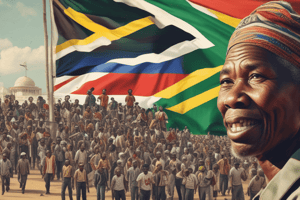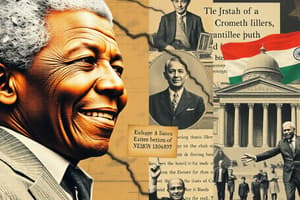Podcast
Questions and Answers
Which Act dispossessed Black people of their land?
Which Act dispossessed Black people of their land?
- Group Areas Act
- Defence Act of 1912
- Population Registration Act
- Black Land Act of 1913 (correct)
The Group Areas Act enforced segregation in urban areas.
The Group Areas Act enforced segregation in urban areas.
True (A)
What was one outcome of the 1913 Act?
What was one outcome of the 1913 Act?
Prevention of black rights enforcement in Cape.
The first South African women allowed to vote in 1931 were _____ women.
The first South African women allowed to vote in 1931 were _____ women.
Which of the following measures was taken to commence reform post-1991?
Which of the following measures was taken to commence reform post-1991?
What did the Nationalist government focus on after coming to power in 1948?
What did the Nationalist government focus on after coming to power in 1948?
Who was released in 1991 that marked a significant political change?
Who was released in 1991 that marked a significant political change?
Match the following terms with their descriptions:
Match the following terms with their descriptions:
Flashcards are hidden until you start studying
Study Notes
Apartheid History and Its Foundations
- Brutality of pre-democracy South Africa was rooted in Parliament’s racist laws, establishing a system of discrimination before 1948.
- Early segregation measures were introduced during the Dutch and English colonial periods in the Cape.
- After the Union of 1910, segregation based on race was further entrenched by English policies.
- The Nationalist government came to power in 1948, leading to an increase in racially-based legislation.
Key Apartheid Legislation
- Black Land Act of 1913: Dispossessed Black people of their land, prohibiting land ownership and enforcing return to ancestral lands.
- Homeland system: Created "independent homelands" for Black people, limiting them to specific, often impoverished areas.
- Group Areas Act: Enforced racial segregation by designating specific areas for different racial groups based on classifications.
Social Impact of Apartheid
- A system of passes restricted movement for non-White populations, extensively categorizing and segregating communities.
- Courts for Black individuals operated separately, upholding apartheid law and contributing to colonial-era violence.
- The legacy of apartheid remains evident today in entrenched disparities in land ownership, resource access, justice, and ongoing poverty.
Political Developments
- Formation of political parties such as the African National Congress (ANC) and the Pan Africanist Congress (PAC) in response to oppression.
- Anti-government protests became common after 1913, especially against injustices like pass laws and forced labor.
Steps Towards Reform
- By 1984, measures began to dismantle aspects of apartheid, but conservative groups resisted change.
- Significant legislative changes occurred post-1991, unbanning political parties and paving the way for Nelson Mandela’s release.
- The Abolition of Racially Based Measures Act of 1991 repealed racially discriminatory laws, assisting in land claim settlements pre-1994 Constitution.
Notable Events and Legislation
- 1910: Union formation led to loss of tribal living and control over land for Black individuals.
- 1906: Natal and Zululand riots against oppressive pass laws resulted in further suppression of Black leaders.
- 1911: Prohibition of strikes by Black workers enacted; the mining sector favored cheap Black labor.
- 1931: Limited voting rights introduced for white women, aimed at reducing the Black electorate.
- 1948: Malan's government intensified apartheid measures, including the ban on interracial marriages in 1949, with limited registrations at that time.
Continued Segregation Practices
- The Group Areas Act of 1950 formalized urban racial segregation across South Africa.
- Apartheid laws encompassed various layers of society, aiming to enforce geographical and ethnic separations.
- Pretoria became a focal point for ‘cultural re-awakening’, emphasizing traditional structures in rural governance, amidst the oppression.
Studying That Suits You
Use AI to generate personalized quizzes and flashcards to suit your learning preferences.




